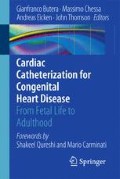Abstract
Stents have been used in congenital heart disease since the late 1980s with increasing experience and application in more diverse lesions at all ages over the past few years. The earliest balloon-expandable stents were mounted onto a balloon catheter with a crimper device and carefully passed through a previously placed long delivery sheath that crossed the lesion. Stents slipping off the balloon during this passage or at the time of inflation were the most significant problems. More reliable mounting techniques and the development of premounted stents have virtually eliminated this problem. While a long sheath is still commonly used, the premounted stent can also be safely placed without using a long sheath. Meticulous attention to detail is the key to both avoiding complications and being able to deal with them, and a stable guide wire position is essential. Vessel rupture from overexpansion of a stent can occur and covered stents are now electively placed in very tight stenoses. They are also able to seal aneurysms or dissections from previous surgery, balloon dilation or bare-metal stents. Open-cell stents allow access to side branches “jailed” by the stent and dilating and stenting through the side of a stent is increasingly performed. Stents that have reached their limit of expansion can be disrupted with high-pressure balloons to allow placement of a stent with a larger diameter inside the original to avoid surgical resection.
Access this chapter
Tax calculation will be finalised at checkout
Purchases are for personal use only
References
Ing F (2002) Stents: what’s available to the pediatric interventional cardiologist? Catheter Cardiovasc Interv 57(3):374–386
Mullins CE (2006) Intravascular stents in congenital heart disease – general considerations, equipment. In: Mullins CE (ed) Cardiac catheterization in congenital heart disease: pediatric and adult. Blackwell Futura, Malden, pp 537–596
Peters B, Ewert P, Berger F (2009) The role of stents in the treatment of congenital heart disease: current status and future perspectives. Ann Pediatr Cardiol 2(1):3–23
Author information
Authors and Affiliations
Corresponding author
Editor information
Editors and Affiliations
Rights and permissions
Copyright information
© 2015 Springer-Verlag Italia
About this chapter
Cite this chapter
Rosenthal, E., Goreczny, S. (2015). Stents. In: Butera, G., Chessa, M., Eicken, A., Thomson, J. (eds) Cardiac Catheterization for Congenital Heart Disease. Springer, Milano. https://doi.org/10.1007/978-88-470-5681-7_8
Download citation
DOI: https://doi.org/10.1007/978-88-470-5681-7_8
Published:
Publisher Name: Springer, Milano
Print ISBN: 978-88-470-5680-0
Online ISBN: 978-88-470-5681-7
eBook Packages: MedicineMedicine (R0)

